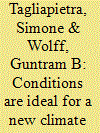| Srl | Item |
| 1 |
ID:
191244


|
|
|
|
|
| Summary/Abstract |
The European Union (EU) recently declared its intention to implement a carbon border adjustment mechanism (CBAM) to address carbon leakage and competitiveness concerns associated with elevated climate ambitions in its Green Deal. Current literature points to uncertainties regarding the CBAM’s effectiveness and compatibility with international trade rules. This study numerically evaluates how alternative EU CBAM designs under various international reactions affect global and regional GHG emissions, outputs and trade flows.
|
|
|
|
|
|
|
|
|
|
|
|
|
|
|
|
| 2 |
ID:
181470


|
|
|
|
|
| Summary/Abstract |
Annual global greenhouse-gas emissions have been rising steadily for decades and show no sign of peaking. That is, humankind is not making enough progress to exclude a possibly catastrophic climate scenario. Protecting the climate is difficult because of free-riding: emissions abatement costs are largely national but the benefits from climate stability are global. Dealing with this problem needs to be at the core of a new climate strategy. This article argues that both technological and political conditions are now ideal to establish a new climate club, in which members commit to stronger domestic climate measures and agree on the coordinated introduction of carbon border adjustment measures. On the technology side, there have been stunning clean technology cost reductions. This will underpin the climate club: as abatement costs fall, club stability can be more easily achieved. On the political side, we now see the United States, European Union and China – representing half of global greenhouse gas emissions – sharing for the first time a common climate ambition while popular support in all economies is also high for substantial climate actions. These two changes make a climate club more likely stable as the benefits from deviating from the club have diminished. A relatively weak penalty, such as carbon border adjustment measure, may then suffice for club stability. This climate club would also create incentive for other countries to join the club, thus making it a catalyst for tougher climate action worldwide.
|
|
|
|
|
|
|
|
|
|
|
|
|
|
|
|